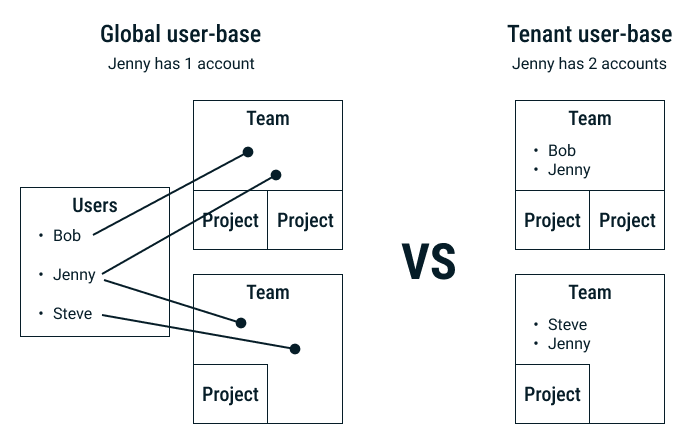使用 honeystone/context 构建多租户应用程序
不要与 Laravel 的新上下文库混淆,该包可用于构建多上下文多租户应用程序。大多数多租户库本质上都有一个“租户”上下文,因此如果您需要多个上下文,事情可能会变得有点麻烦。这个新包解决了这个问题。
让我们看一个示例吧?
示例项目
对于我们的示例应用程序,我们将拥有一个全球用户群,即组织成团队,每个团队将有多个项目。这是许多软件即服务应用程序中相当常见的结构。
对于多租户应用程序来说,每个用户群都存在于租户上下文中并不罕见,但对于我们的示例应用程序,我们希望用户能够加入多个团队,所以是全球用户群。
全球用户群与租户用户群图

作为 SaaS,很可能该团队将是计费实体(即席位),并且某些团队成员将被授予管理团队的权限。不过,我不会在这个示例中深入探讨这些实现细节,但希望它提供一些额外的上下文。
安装
为了保持这篇文章的简洁,我不会解释如何启动你的 Laravel项目。已经有许多更好的资源可用,尤其是官方文档。让我们假设您已经有一个 Laravel 项目,包含用户、团队和项目模型,并且您已准备好开始实现我们的上下文包。
安装是一个简单的作曲家推荐:
composer install honeystone/context
这个库有一个方便的函数 context(),从 Laravel 11 开始,它与 Laravel 自己的 context 函数发生冲突。这并不是真正的问题。您可以导入我们的函数:
use function Honestone\Context\context;
或者只使用 Laravel 的依赖注入容器。在这篇文章中,我将假设您已导入该函数并相应地使用它。
模型
让我们从配置我们的团队模型开始:
<?php declare(strict_types=1);
namespace App\Models;
use Illuminate\Database\Eloquent\Model;
use Illuminate\Database\Eloquent\Relations\BelongsToMany;
use Illuminate\Database\Eloquent\Relations\HasMany;
class Team extends Model
{
protected $fillable = ['name'];
public function members(): BelongsToMany
{
return $this->belongsToMany(User::class);
}
public function projects(): HasMany
{
return $this->hasMany(Project::class);
}
}团队有名称、成员和项目。在我们的应用程序中,只有团队成员才能访问该团队或其项目。
好的,让我们看看我们的项目:
<?php declare(strict_types=1);
namespace App\Models;
use Illuminate\Database\Eloquent\Model;
use Illuminate\Database\Eloquent\Relations\BelongsTo;
class Project extends Model
{
protected $fillable = ['name'];
public function team(): BelongsTo
{
return $this->belongsTo(Team::class);
}
}一个项目有一个名称并属于一个团队。
确定上下文
当有人访问我们的应用程序时,我们需要确定他们在哪个团队和项目中工作。为了简单起见,我们用路由参数来处理这个问题。我们还假设只有经过身份验证的用户才能访问该应用程序。
团队和项目上下文都不是: app.mysaas.dev
仅团队上下文: app.mysaas.dev/my-team
团队和项目上下文: app.mysaas.dev/my-team/my-project
我们的路线将如下所示:
Route::middleware('auth')->group(function () {
Route::get('/', DashboardController::class);
Route::middleware(AppContextMiddleware::Class)->group(function () {
Route::get('/{team}', TeamController::class);
Route::get('/{team}/{project}', ProjectController::class);
});
});考虑到命名空间冲突的可能性,这是一种非常不灵活的方法,但它使示例保持简洁。在现实世界的应用程序中,您需要稍微不同地处理这个问题,也许是 anothersaas.dev/teams/my-team/projects/my-project 或 my-team.anothersas.dev/projects/my-project。
我们应该首先看看我们的 AppContextMiddleware。该中间件初始化团队上下文,以及项目上下文(如果已设置):
<?php declare(strict_types=1);
namespace App\Http\Middleware;
use function Honestone\Context\context;
class TeamContextMiddleware
{
public function handle(Request $request, Closure $next): mixed
{
//pull the team parameter from the route
$teamId = $request->route('team');
$request->route()->forgetParameter('team');
$projectId = null;
//if there's a project, pull that too
if ($request->route()->hasParamater('project')) {
$projectId = $request->route('project');
$request->route()->forgetParameter('project');
}
//initialise the context
context()->initialize(new AppResolver($teamId, $projectId));
}
}首先,我们从路由中获取团队 ID,然后忘记路由参数。一旦参数进入上下文,我们就不需要到达控制器。如果设置了项目 ID,我们也会提取它。然后,我们使用 AppResolver 传递团队 id 和项目 id(或 null)来初始化上下文:
<?php declare(strict_types=1);
namespace App\Context\Resolvers;
use App\Models\Team;
use Honeystone\Context\ContextResolver;
use Honeystone\Context\Contracts\DefinesContext;
use function Honestone\Context\context;
class AppResolver extends ContextResolver
{
public function __construct(
private readonly int $teamId,
private readonly ?int $projectId = null,
) {}
public function define(DefinesContext $definition): void
{
$definition
->require('team', Team::class)
->accept('project', Project::class);
}
public function resolveTeam(): ?Team
{
return Team::with('members')->find($this->teamId);
}
public function resolveProject(): ?Project
{
return $this->projectId ?: Project::with('team')->find($this->projectId);
}
public function checkTeam(DefinesContext $definition, Team $team): bool
{
return $team->members->find(context()->auth()->getUser()) !== null;
}
public function checkProject(DefinesContext $definition, ?Project $project): bool
{
return $project === null || $project->team->id === $this->teamId;
}
public function deserialize(array $data): self
{
return new static($data['team'], $data['project']);
}
}这里还有更多内容。
define( ) 方法负责定义正在解析的上下文。团队是必需的,并且必须是团队模型,并且项目被接受(即可选)并且必须是项目模型(或为空)。
resolveTeam() 将在初始化时在内部调用。它返回 Team 或 null。如果出现空响应,ContextInitializer 将抛出 CouldNotResolveRequiredContextException。
resolveProject() 也将在初始化时在内部调用。它返回项目或 null。在这种情况下,空响应不会导致异常,因为定义不需要该项目。
解析团队和项目后,ContextInitializer 将调用可选的 checkTeam() 和 checkProject() 方法。这些方法执行完整性检查。对于 checkTeam(),我们确保经过身份验证的用户是团队的成员,对于 checkProject(),我们检查项目是否属于团队。
最后,每个解析器都需要一个 deserialization() 方法。此方法用于恢复序列化上下文。最值得注意的是,当在排队作业中使用上下文时,会发生这种情况。
Now that our application context is set, we should use it.
Accessing the context
As usual, we’ll keep it simple, if a little contrived. When viewing the team we want to see a list of projects. We could build our TeamController to handle this requirements like this:
<?php declare(strict_types=1);
namespace App\Http\Controllers;
use Illuminate\View\View;
use function compact;
use function Honestone\Context\context;
use function view;
class TeamController
{
public function __invoke(Request $request): View
{
$projects = context('team')->projects;
return view('team', compact('projects'));
}
}Easy enough. The projects belonging to the current team context are passed to our view. Imagine we now need to query projects for a more specialised view. We could do this:
<?php declare(strict_types=1);
namespace App\Http\Controllers;
use Illuminate\View\View;
use function compact;
use function Honestone\Context\context;
use function view;
class ProjectQueryController
{
public function __invoke(Request $request, string $query): View
{
$projects = Project::where('team_id', context('team')->id)
->where('name', 'like', "%$query%")
->get();
return view('queried-projects', compact('projects'));
}
}It’s getting a little fiddly now, and it’s far too easy to accidentally forget to ‘scope’ the query by team. We can solve this using the BelongsToContext trait on our Project model:
<?php declare(strict_types=1);
namespace App\Models;
use Honeystone\Context\Models\Concerns\BelongsToContext;
use Illuminate\Database\Eloquent\Model;
use Illuminate\Database\Eloquent\Relations\BelongsTo;
class Project extends Model
{
use BelongsToContext;
protected static array $context = ['team'];
protected $fillable = ['name'];
public function team(): BelongsTo
{
return $this->belongsTo(Team::class);
}
}All project queries will now be scooped by the team context and the current Team model will be automatically injected into new Project models.
Let’s simplify that controller:
<?php declare(strict_types=1);
namespace App\Http\Controllers;
use Illuminate\View\View;
use function compact;
use function view;
class ProjectQueryController
{
public function __invoke(Request $request, string $query): View
{
$projects = Project::where('name', 'like', "%$query%")->get();
return view('queried-projects', compact('projects'));
}
}That’s all folks
From here onwards, you’re just building your application. The context is easily at hand, your queries are scoped and queued jobs will automagically have access to the same context from which they were dispatched.
Not all context related problems are solved though. You’ll probably want to create some validation macros to give your validation rules a little context, and don’t forget manual queries will not have the context automatically applied.
If you’re planning to use this package in your next project, we’d love to hear from you. Feedback and contribution is always welcome.
You can checkout the GitHub repository for additional documentation. If you find our package useful, please drop a star.
Until next time..
This article was originally posted to the Honeystone Blog. If you like our articles, consider checking our more of our content over there.
以上是使用 honeystone/context 构建多租户应用程序的详细内容。更多信息请关注PHP中文网其他相关文章!

热AI工具

Undresser.AI Undress
人工智能驱动的应用程序,用于创建逼真的裸体照片

AI Clothes Remover
用于从照片中去除衣服的在线人工智能工具。

Undress AI Tool
免费脱衣服图片

Clothoff.io
AI脱衣机

AI Hentai Generator
免费生成ai无尽的。

热门文章

热工具

记事本++7.3.1
好用且免费的代码编辑器

SublimeText3汉化版
中文版,非常好用

禅工作室 13.0.1
功能强大的PHP集成开发环境

Dreamweaver CS6
视觉化网页开发工具

SublimeText3 Mac版
神级代码编辑软件(SublimeText3)

热门话题
 php中的卷曲:如何在REST API中使用PHP卷曲扩展
Mar 14, 2025 am 11:42 AM
php中的卷曲:如何在REST API中使用PHP卷曲扩展
Mar 14, 2025 am 11:42 AM
PHP客户端URL(curl)扩展是开发人员的强大工具,可以与远程服务器和REST API无缝交互。通过利用Libcurl(备受尊敬的多协议文件传输库),PHP curl促进了有效的执行
 在Codecanyon上的12个最佳PHP聊天脚本
Mar 13, 2025 pm 12:08 PM
在Codecanyon上的12个最佳PHP聊天脚本
Mar 13, 2025 pm 12:08 PM
您是否想为客户最紧迫的问题提供实时的即时解决方案? 实时聊天使您可以与客户进行实时对话,并立即解决他们的问题。它允许您为您的自定义提供更快的服务
 解释PHP中晚期静态结合的概念。
Mar 21, 2025 pm 01:33 PM
解释PHP中晚期静态结合的概念。
Mar 21, 2025 pm 01:33 PM
文章讨论了PHP 5.3中引入的PHP中的晚期静态结合(LSB),从而允许静态方法的运行时分辨率调用以获得更灵活的继承。 LSB的实用应用和潜在的触摸
 在PHP API中说明JSON Web令牌(JWT)及其用例。
Apr 05, 2025 am 12:04 AM
在PHP API中说明JSON Web令牌(JWT)及其用例。
Apr 05, 2025 am 12:04 AM
JWT是一种基于JSON的开放标准,用于在各方之间安全地传输信息,主要用于身份验证和信息交换。1.JWT由Header、Payload和Signature三部分组成。2.JWT的工作原理包括生成JWT、验证JWT和解析Payload三个步骤。3.在PHP中使用JWT进行身份验证时,可以生成和验证JWT,并在高级用法中包含用户角色和权限信息。4.常见错误包括签名验证失败、令牌过期和Payload过大,调试技巧包括使用调试工具和日志记录。5.性能优化和最佳实践包括使用合适的签名算法、合理设置有效期、
 如何用PHP的cURL库发送包含JSON数据的POST请求?
Apr 01, 2025 pm 03:12 PM
如何用PHP的cURL库发送包含JSON数据的POST请求?
Apr 01, 2025 pm 03:12 PM
使用PHP的cURL库发送JSON数据在PHP开发中,经常需要与外部API进行交互,其中一种常见的方式是使用cURL库发送POST�...









